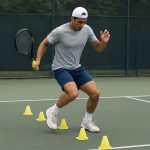How To Practice Tennis at Home
Tennis is a sport that combines agility, strength, and precision. It demands mental acuity and physical prowess, making it a challenging yet rewarding activity. But what if you can’t make it to the court regularly? Whether due to time constraints, weather, or accessibility, you can still hone your skills and improve your game by practicing at home. This flexibility ensures that your passion for tennis doesn’t wane even when court time is limited. Whether you’re a beginner or an experienced player, incorporating tennis drills at home into your routine can keep you sharp and ready for the next match. By making the most of your home environment, you can focus on specific areas of your game that need improvement.
In this guide, we’ll cover various tennis exercises and drills you can perform in the comfort of your home. These exercises are designed to enhance different aspects of your game, from strength and agility to precision and coordination. Let’s dive in!
Before you start practicing tennis at home, it’s important to create a conducive environment. A well-prepared space not only enhances your practice sessions but also minimizes the risk of injury. You don’t need a full-sized court or a net, but a little space and the right mindset can go a long way. Here are some essentials to consider:
- Space: Find an open area in your home, such as a garage, basement, or backyard. Ensure there’s enough room to move around freely. The area should allow for both lateral and forward movements, mimicking the dynamics of a real court. If indoors, ensure the ceiling height is sufficient to avoid hitting overhead lights or fans.
- Equipment: You’ll need a tennis racquet, tennis balls, and a wall or rebounder for ball drills. Optional equipment includes cones or markers for footwork drills. Investing in a few quality items can make your practice sessions more effective and enjoyable. Consider getting a practice net if you have enough space to simulate real-game scenarios.
- Safety: Clear the area of any obstacles or fragile items to prevent accidents. Safety should always be a priority; ensure that the floor is non-slippery and that your shoes provide adequate grip. Additionally, make sure there is proper ventilation, especially if practicing indoors, to keep you comfortable during intense sessions.
Tennis Conditioning at Home
Conditioning is key to improving your tennis performance. A well-conditioned body not only enhances your ability to execute shots effectively but also reduces the risk of injuries. Focusing on strength, agility, and endurance will enhance your on-court abilities, allowing you to play longer and more effectively.
Strength Training
Strength training helps build the muscles you use in tennis, improving your power and stability. A strong foundation is essential for executing powerful serves, groundstrokes, and maintaining balance during rallies. Here are some exercises you can try:
- Push-Ups: This classic exercise strengthens your upper body, crucial for powerful serves and strokes. Incorporate variations like incline or decline push-ups to target different muscle groups and add an extra challenge.
- Lunges: Lunges target your legs and glutes, essential for quick movements on the court. You can perform them in various directions—forward, backward, or lateral—to simulate the multi-directional movement needed in tennis.
- Planks: Strengthen your core with planks, which improve balance and prevent injuries. Try side planks to engage your oblique muscles, which play a critical role in rotational movements during swings.
Agility Drills
Agility is vital for quick direction changes and reaching difficult shots. It allows you to respond swiftly to your opponent’s shots and maintain a competitive edge. Practice these drills to boost your agility:
- Ladder Drills: Use a ladder or draw a grid on the floor with tape. Perform quick steps through each square, varying your pattern to challenge yourself. Incorporate high knees or lateral movements to increase the intensity and improve foot speed.
- Cone Drills: Set up cones in a zigzag pattern and practice sprinting and changing directions swiftly. Experiment with different patterns, such as T-drills or shuttle runs, to keep your workouts dynamic and engaging.
Endurance Exercises
Endurance allows you to maintain your performance throughout a match. A well-developed endurance lets you sustain energy levels, ensuring you remain competitive even in long matches. Incorporate these exercises into your routine:
- Jump Rope: Skipping rope is a fantastic cardio workout that improves your footwork and stamina. Vary your pace and try different patterns like double unders or criss-cross to keep the workout challenging.
- Running in Place: Mimic the movements of a tennis match by running in place, incorporating high knees and lateral movements. Add bursts of speed or simulate the start-stop nature of a tennis rally to mimic match conditions more closely.
Indoor Tennis Exercises
Indoor exercises are perfect for practicing tennis skills when outdoor space is limited. They allow you to focus on technique and repetition, crucial for skill development. These exercises can be done in any room with sufficient space and are ideal for rainy days or when outdoor practice isn’t feasible.
Wall Drills
A wall is an excellent partner for solo tennis drills. It offers instant feedback, helping you improve your reaction time and consistency. Here’s how you can use it:
- Forehand and Backhand Hits: Stand a few feet from the wall and practice your forehand and backhand strokes. Focus on form and consistency. Vary the speed and angle of your shots to simulate different playing conditions and improve adaptability.
- Volley Practice: Stand closer to the wall and hit the ball with short, controlled volleys. This improves your reaction time and control. Try alternating between forehand and backhand volleys to enhance your ability to switch grips quickly.
Shadow Swings
Practicing swings without a ball can help refine your technique. This exercise allows you to focus on form and muscle memory, crucial for executing precise shots during a match:
- Shadow Forehand and Backhand: Stand in front of a mirror or record yourself as you perform forehand and backhand swings. Pay attention to your form and follow-through. Analyze your movements to ensure proper weight transfer and body rotation.
- Serve Practice: Mimic your serving motion to improve your technique and muscle memory. Focus on the toss, swing, and follow-through. Break down each component of the serve to perfect your mechanics and ensure consistency.
At Home Tennis Drills
by Andrey K (https://unsplash.com/@anamnesis33)
Drills are a fundamental part of tennis practice. They enable you to focus on specific aspects of your game, improving your overall performance. Here are some you can do at home:
Footwork Drills for Tennis at Home
Footwork is crucial for positioning yourself to hit the ball effectively. Good footwork allows you to reach balls with precision and maintain balance during play. Practice these drills to enhance your footwork:
- Side Shuffles: Stand with your feet shoulder-width apart and shuffle side to side. This drill improves lateral movement. Incorporate quick changes in direction to simulate the fast-paced nature of a match.
- Split Step: Practice the split step by jumping slightly off the ground and landing softly, ready to move in any direction. This drill helps you stay on the balls of your feet, improving your readiness to react to your opponent’s shots.
Solo Tennis Drills
You don’t need a partner to practice these solo drills. They allow you to work on specific skills and maintain your game when practicing alone:
- Ball Toss Drill: Toss a ball into the air and practice hitting it with your racquet. Focus on timing and contact point. Experiment with different spins and trajectories to challenge yourself and improve your adaptability.
- Target Practice: Set up targets (like cones or boxes) and aim to hit them with your shots. This improves accuracy and control. Adjust the distance and size of the targets to increase the difficulty as your skills improve.
Tennis Drills at Home for Beginners
If you’re new to tennis, start with these beginner-friendly drills. They focus on building a solid foundation and understanding the basic techniques necessary for more advanced play:
Basic Stroke Drills
- Forehand Practice: Stand with your feet shoulder-width apart and practice your forehand swing. Focus on keeping your racquet face perpendicular to the ground. Pay attention to your grip and wrist position to ensure proper stroke mechanics.
- Backhand Practice: Similarly, work on your backhand swing, ensuring proper grip and follow-through. Experiment with both one-handed and two-handed backhands to determine which feels more comfortable and effective.
Coordination Drills
- Ball Toss and Catch: Toss a tennis ball against the wall and catch it with your racquet hand. This drill enhances hand-eye coordination. Progress to catching with your non-dominant hand to challenge your coordination further and improve bilateral skills.
Tennis Training Tips
To make the most of your home practice, keep these tips in mind. They will help you maximize the effectiveness of your training and ensure continuous improvement:
- Consistency: Practice regularly to see improvement. Aim for at least a few sessions per week. Consistency builds muscle memory and reinforces the skills you are working on, leading to noticeable progress over time.
- Warm-Up: Always warm up before starting your drills to prevent injuries. A proper warm-up increases blood flow to your muscles, reducing the risk of strains and enhancing performance.
- Focus on Technique: Prioritize proper form over speed or power. Good technique is the foundation of effective tennis play and minimizes the risk of injury while maximizing efficiency.
- Stay Motivated: Set achievable goals and track your progress to stay motivated. Celebrate small victories to keep yourself encouraged and maintain a positive mindset throughout your training journey.
Conclusion
Practicing tennis at home is an excellent way to maintain and improve your skills, even when you can’t get to the court. By incorporating these drills and exercises into your routine, you’ll be better prepared for your next match. Remember, the key is consistency and dedication. With regular practice, you can develop the skills and confidence needed to excel in your game. Happy practicing!











